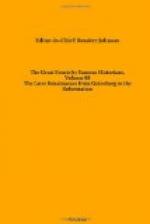THE CLASH OF RACES IN THE EAST
The Turks had recovered from their defeat by the Tartars of Timur, and became once more an active menace. With Constantinople in their power, they attacked the Venetians and compelled those wealthy traders to pay them tribute. Venice by sea and Hungary on land remained for a century the bulwarks of Christendom, and were forced, almost unaided, to withstand all the assaults of the East. They wellnigh perished in the effort. In Hungary this was the period of the great hero, Hunyady, a man of unknown birth and no official rank, who roused his countrymen to repeated effort and led them to repeated victories and defeats against the vastly more numerous invaders.[5]
Hunyady died, worn out with ceaseless warfare, and his son, Matthias, was elected by acclamation to be monarch of the land the father had preserved. This was the proudest era in the history of the Hunnish race. Under Matthias they even resumed their German warfare of five centuries before, and won from a Hapsburg emperor his city of Vienna, ancient capital of Austria, the eastmark or borderland which had been erected by Otto the Great to hold the Huns in check. For a few years Matthias placed his kingdom amid the foremost states of Europe; but with his death came renewed disunion and disorder to his lawless people, and the fierce, fanatic Turks returned again to their assaults.
Further north the yellow races were less successful. Along the shifting borderlands of Asia which mark the line of demarcation between the two mightier families of man, the tide turned ever more steadily in the Aryans’ favor. The Russians, under their chief, Ivan III, threw off the galling Tartar yoke which they had borne for over two hundred years. Ivan concentrated in his own hands the power of all the little Russian duchies, overthrew the celebrated Russian republic of Novgorod the Great, and defied the Tartars. Equally noteworthy to modern eyes was his wedding with Sophia, heiress of the last of the emperors of the East. When that outworn empire perished with the fall of Constantinople, Ivan succeeded nominally at least to its heirship. Hence it is that his successors have assumed the title of caesar or kaiser or czar and have grown to look upon themselves as inheritors of the ancient supremacy of Rome.[6]
The fifteenth century was thus a time of many changes in Eastern Europe. Not only did the Eastern Empire disappear at last, not only did Hungary rise to the brief zenith of her glory, there was a sort of general movement, sometimes spoken of as the “Slavonic reaction,” against the hitherto successful Teutons. The Slavic Bohemians in their “Hussite” wars repelled all the religious fighting strength of Europe. The Poles began to win back territory from the German empire, and especially from their hereditary foes the “Teutonic Knights” of Prussia. And Russia, greatest of all the Slav countries, grew into a strong kingdom. She and Turkey, rising as twin menaces to the West, assumed at almost the same period that threatening aspect which Turkey has only lately lost, and Russia, to some statesmen’s eyes, still holds.




